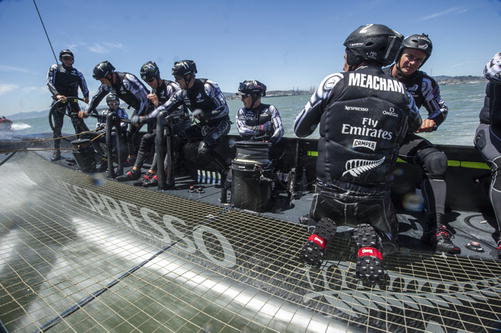Fig. 22.1
Open class “Clan des Team” at the Centomiglia del Garda regatta, Lake Garda, Italy. (Photo: Davide Casadio)
) while new equipment and race formats with an emphasis on speed and spectacular maneuvers continue to attract the attention of the media and general public.
These features allow modern sailing to be counted among other extreme sports. In particular, offshore sailing competitions which are held in hostile and unpredictable environmental conditions maintain the spirit of ancient pioneering expeditions while fleet regattas and match races are characterized by breathtaking and high-speed maneuvers. As sailboat performance advances, so does the demand for ever-greater physical and mental performance on the part of athletes. As a result, medical support such as advising on the choice of equipment and the most efficient safety systems, optimizing the athletic preparation of crew members, and the prevention and rehabilitation of any injuries and illnesses sustained becomes ever-increasingly important.
22.2 Sailing Injuries and Illnesses
Today, there is a wide range of ways to experience amateur and professional sailing, and event formats range from match races to fleet regattas and ocean races. The many sailing schools throughout the world allow the sport to be practiced safely at any age. Even amateur practice, which almost invariably represents the initial approach to this sport, may involve certain risks, especially if the appropriate precautions are not taken.
The significant differences among sailing classes require differentiated and targeted medical approaches. Indeed, in the Olympic classes and in the America’s Cup, the high demands made on the athletes expose them to the risk of various and specific medical conditions that are mainly linked to poor technical execution, overloading and fatigue. The America’s Cup in particular places highly variable demands on sailors depending on their specific role requiring long preparation times and high workloads. Finally, in offshore sailing, the environmental conditions and demanding pace of life are highly stressful and need to be sustained over long periods. This leads to the onset of various injuries and illnesses almost always difficult to treat in remote areas far from medical access.
22.3 Recreational Sailing and Beginners
22.3.1 Injuries
Both recreational and novice dinghy sailors mainly report acute injuries [1, 2]. Schaefer studied injuries among 536 students enrolled in basic sailing courses in Kiel, Germany, and found an injury rate of 0.29 injuries per 1000 h of sailing [1]. Of 238 injuries, 39.5 % were to the upper limbs, 32.8 % to the head and neck, 26.5 % to the lower limbs, and only 0.8 % were to the back. Most of the injuries were bruises (55.1 %; n = 133), abrasions (17.2 %; n = 41) and cuts (14.3 %; n = 34). Mainly sustaining cuts and lacerations, the hand was the most involved upper limb part in the vast majority of cases (88 %; n = 83). More than a quarter of these injuries occurred while handling the sheet. Almost all head injuries were contusions from hitting the boom or the mainsheet during maneuvers or following a loss of control of the boat. Knee contusions mainly caused by contact with the hull (31.0 %; n = 9), winches (20.7 %; n = 6) or the dagger board case (20.7 %; n = 6) were also common. The majority of injuries (40.7 %; n = 97) were suffered by helmsmen and were related to the greater variety and complexity of the actions required by their role on board; bowmen were victims of about a quarter (26.5 %; n = 63) of the injuries; and the remaining injuries were not specific to either of these roles. In wind speed range between 1 and 5 Bft, the higher the wind speed, the higher the risk of injury. Injuries among novices are more common when sailing in onshore wind; especially at sea, wind raises waves near the shore break rendering not only navigation difficult for inexperienced crews but also exit and reentry.
In their series of predominantly amateur sailors, Nathanson et al. [2] found an injury rate of 4.6 per 1000 days of sailing. The pattern of injury in dinghies and keel boats was similar: in dinghies, the lower extremities were more commonly affected (44 %) followed by the upper extremities (38 %) and head/neck (12 %), while in keel boats, most of the injuries were to the upper limbs (40 %), lower limbs (38 %), and trunk (11 %). Leg contusions were the most common injuries overall; knee contusions prevailed in dinghies while hand lacerations were among the most common injuries in keelboats, the main causes being entanglement in lines and collision with winches and cleats. Head, face, and eye injuries represented roughly 10 % of injuries both in dinghies and keelboats, and more than half resulted from impact with the boom and spinnaker pole, usually during maneuvers in heavy weather. Maneuvers such as tacking, jibing and sail changing were the root of injuries in about 40 % of cases in both dinghies and keel boats; the activities more often associated with injuries were crossing from one side of the boat to the other during maneuvers, operating a winch and steering. Most injuries were caused by falls, a sailor becoming caught in lines, or collisions with fellow crew members or objects such as a boom, spinnaker pole or sail clew. About half of the injuries were sustained in the cockpit in both keelboats and dinghies, while injuries occurring on the mid-ship prevailed in dinghies and on the foredeck in keelboats. Inclement weather was the most predominant contributing factor to injuries as it was involved in 19 and 23 % of injuries on dinghies and keelboats respectively.
22.3.2 Prevention
To avoid injuries among beginning and amateur sailors, the use of equipment that simplifies activities on board and increases safety may be the most effective strategy. This allows for a safe process of learning and practice. Sailboats should comply with certain medical and ergonomic guidelines especially when designed for beginners: rounded forms rather than sharp edges should be adopted especially for the deck and drift while cleats, winches, and bailers should be positioned in places with reduced likelihood of haphazard contact.
Impact with the boom or mainsheet is the most common cause of injuries among beginners (31.1 %; n = 74) [1], and these consist almost exclusively of head lacerations and contusions. The most recent sail profiles provide a high degree of propulsion even with smaller sails allowing the boom to be mounted higher on the mast with no significant change to the center of effort and no increased risk of capsizing. This design change is particularly useful on boats adopted by sailing schools where maximum performance is not the main objective. Falls or tripping can be prevented by properly stowing equipment on board and by applying anti-slip paint to passageways.
Non-slip shoes and sailing gloves may prevent falls and hand injuries. Indeed, some of the most severe injuries on all types of boats are those to the hands (34.9 % of all injuries), and the use of hardwearing, performance sailing gloves is particularly recommended to protect hands against both injury and atmospheric agents. Gloves are particularly important in cold climate conditions and when handling ropes under high tension, especially when trimming spinnaker sails (Fig. 22.2
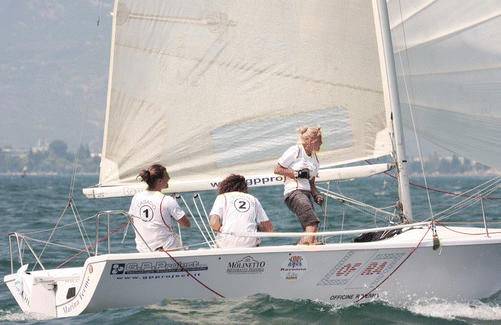
). To avoid abrasions and lacerations to the hands, shrouds and ropes should be of the highest caliber and should be changed regularly to assure they are always as smooth and soft as possible.

Fig. 22.2
Crew of a UFO 22 sailing on a beam reach. Bowman trimming spinnaker, wearing gloves (Photo: Davide Casadio)
Life jackets should be worn at all times while sailing on any and all types of boats. The annual fatality for recreational sailors in 2012 in the USA was 0.35/100,000 participants. Drowning was the cause of 73 % of recreational boating deaths in the same year with most of the fatalities resulting from falls overboard (40.9 %) or capsizing (28.8 %). Furthermore, 77 % percent of sailors who drowned in 2012 in the USA were not wearing a life jacket [3] (Fig. 22.3

).

Fig. 22.3
Open class “Raffica” at the Centomiglia del Garda regatta, Lake Garda, Italy. The boat capsized due to the breakage of the keel (Photo: Davide Casadio)
Fatigue or trauma related to falls into water may compromise or reduce people’s ability to bring themselves to safety and even to swim. In case of head injury followed by a fall in water, a life jacket with head support can protect against drowning. Despite all efforts by national federations and World Sailing (formerly known as ISAF – International Sailing Federation) to encourage their use in sailing schools and during regattas, many amateur sailors are still reluctant to wear life jackets. In the study by Nathanson et al. [2], only 30 % of amateur sailors wear a life jacket. However, there are a variety of products available on the market now whose models suit all requirements and levels of experience from beginners to professionals.
22.4 Olympic Sailing
Sailing is one of the oldest sports in the Olympic program. It was first included in the 1900 Olympic Games. It made its next Olympic appearance in 1908 and has been part of every competition since. Today, the Olympic classes include single-handed dinghies (Finn, Laser, and Laser Radial), double-handed dinghies (470), sailboards (RS:X), a multihull class (Nacra 17) and skiffs (49er and 49er FX) (Fig. 22.4
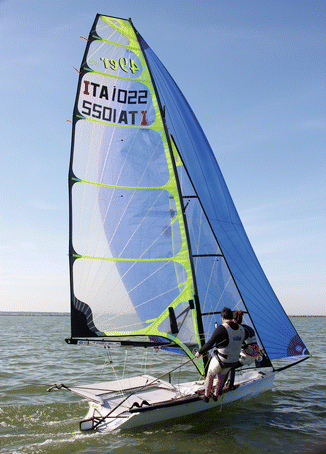
) [4].

Fig. 22.4
49er is the two-handed skiff-type high-performance Olympic Class. It is powered by a main sail, jib, and 37.16 m2 triradial asymmetric spinnaker, and both of the crew members are equipped with their own trapeze. The class has been in everyOlympic Games since its debut in Sydney, 2000 (Photo: Davide Casadio)
22.4.1 Injuries
Using a questionnaire, Legg et al. [5] found an incidence of 0.2 injuries/athlete/year among 28 elite New Zealand Olympic-class sailors. Out of 380 sailing athletes competing at the London Olympic Games [6] (27 July – 12 August 2012), 56 (14.7 %) sustained injuries requiring medical attention, mainly to the lower limbs (34 %) and trunk (28.5 %), with the thoracic and lumbar spine being involved in 19.6 % of the injuries, followed by the upper limbs (25 %) and the head/neck (7.1 %). Most of the injuries (28.6 %) were muscular injuries (strains, ruptures, or tears), contusions (12.5 %; n = 7), and sprains (10.7 %; n = 6).
A study on young Swedish Olympic-class sailors confirmed that lower limbs were the main body part affected by injuries (43 %), the knee being the most commonly reported injury location (19 %) [7]. Among national elite sailors taking part in the Pre-Olympic Sailing Week, the most reported diagnostic muscular injuries were to the back and knee (Ruschel et al. [8]). Olympic-class athletes appear to be more prone to overuse injuries than to sudden onset injuries [6, 8]. Injuries in these athletes are often caused by a poor balance between work and recovery time [8–10]. These Olympic sailing classes also require athletes to maintain unnatural positions (hyperextension, locking, or twisting) for long periods to optimize the trim of the boat resulting in postural overloading and stress to joints.
Hiking is a practice consisting of the crew leaning over the side of the boat maintaining their hold using toe straps for the purpose of counter balancing the wind heel force in order to increase the speed of the boat. Hiking is practiced on single-handed dinghies (Laser, Finn, and Laser Radial), and it is associated with overuse injuries to the knees and back [5, 11–14].
The hiking technique differs among classes: in laser sailing (Fig. 22.5
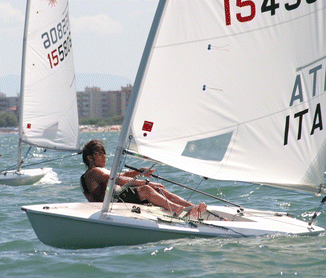
), the straight-leg position creates a load moment both on the lumbar spine and the knee, while in Finn, the hiking position with not completely extended legs increases the shear force acting on the knee [10, 14]. Chronic knee pain associated with chondromalacia patella may arise as a consequence of an incorrect foot position under the foot straps with the leg in internal rotation. This causes the load to move on the vastus lateralis muscle which, over time, is prone to develop to a greater extent compared to the other heads of the quadriceps femoris thereby predisposing it to excessive lateral patellar compression syndrome [14].

Fig. 22.5
Hiking on a laser (Photo: Davide Casadio)
In elite dinghy sailors, hiking may also cause an imbalance in the hamstring/quadricep strength ratio impairing the stability of the knee joint against anterior-posterior shear forces and bone-on-bone stress forces [14–16]. Another problem due to hiking is iliopsoas overload causing hyperlordosis characterized by high compression forces on the spine at a time when it is also subjected to shear force. This potentially leads to chronic injuries [14]. Overloading of the upper limbs (elbows and shoulders in particular) is also common among elite athletes involved in Olympic-class competitions due to the need for frequent adjustment of the mainsheet especially on heavier boats and when sailing in more strenuous conditions [7].
22.4.2 Prevention
Knee cartilage injury following prolonged hiking is potentially serious and may require surgical repair [2]. Knee and lower back overuse injuries should therefore be prevented by improving technique, optimizing posture, and gradually training strength [12]. In all Olympic classes, a proper training regime to prevent injuries should include a strengthening of synergist and joint-stabilizing muscles along with core stability and proprioceptive training. Specific training should also be undertaken depending on the particular sailing class. In those involving hiking, strengthening of the femoral quadriceps and abdominal muscles has a direct effect on performance. It is also important to prevent any muscle imbalances and articular misalignment by way of appropriate exercises for hamstring and lumbar muscle strength and flexibility. In Olympic-class sailors, 30 % of injuries were related to physical training, the majority occurring at the beginning of the sailing season. Programs should therefore be tailored to specific individual physical characteristics, and an appropriate training plan ensuring a gradual transition to the sailing season may contribute to injury prevention [7]. The transition of young sailors from the smaller Optimist dinghies to the more demanding Olympic classes is a particularly critical phase that should be accompanied by proper preparation to improve technique, muscle strength and proprioception.
22.5 America’s Cup
America’s Cup is the world’s most famous sailing and the oldest international sporting trophy. It is governed by several rules and documents, and the permitted boat models change from one competition to the next. The 33rd challenge was the first to include multihulls while the 34th was held with AC72 (America’s Cup 72 class) catamarans with an overall length of 26.2 m (86 ft) and a crew of eleven people. These craft are powered by a 131-ft carbon wing and skim above the water on hydrofoils enabling them to sail at speeds well over 40 knots (74 km/h, 46 mph) (Fig. 22.6
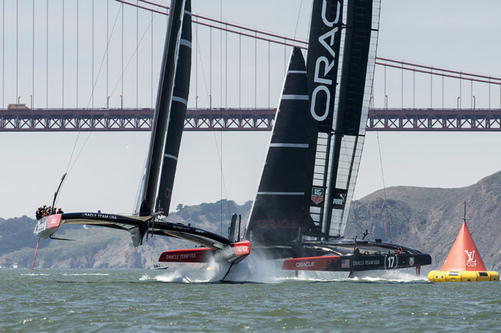
).

Fig. 22.6
US Oracle Team practices in training races on the Louis Vuitton Cup course in San Francisco, 21/8/2013 (Photo: Chris Cameron)
AC48s are the permitted wing sail catamarans in the upcoming 35th challenge. They feature a length of 14.65 m (48.1 ft.), a maximal air draft of 24.9 m (81.7 ft.) and a six-man crew [17]. The challenger team in the America’s Cup is the winner of a selection series called the Louis Vuitton Cup. The preparation for the America’s Cup involves a challenging program of training over a period of 2–4 years, during which the crew is involved in both land-based activities and on-water sailing for 9–13 h a day [18].
22.5.1 Injuries
In a study on 35 sailors during the preparatory phase and holding of the 2003 America’s Cup, Neville et al. found an injury rate of 5.7 injuries/1000 h. The overall number of injuries in training and sailing were similar, but given that the time spent sailing was three times more than that spent training, the incidence of injury during training was approximately four times higher (8.6/1000 training hours) than during sailing (2.2/1000 sailing hours). Injury incidence and patterns depend on crew roles; particularly when including both land-based activities, and weight training, grinders have a higher risk of injuries (7.7/1000 h) due to significant strength and power requirements. Considering sailing only, the crew role suffering the highest incidence of injury is that of bowmen (3.2/1000 h). This post requires high-intensity activity that is carried out in the most highly unstable area of the bow [18, 19].
The most affected body parts were upper limbs (40 %), lower limbs (25 %), trunk (20 %), and head/neck (14 %) [19]. Although there is contrasting data as to whether acute or overuse injuries are more common in the America’s Cup, overuse injuries were more severe than acute ones in terms of days of absence from training and sailing activities [19, 20]. Hiking is not practiced on boats participating in the America’s Cup, hence, crew-members are not subjected to back and knee overuse problems that are typical of dinghy sailors [19]. However, high-repetition activities such as grinding, top-handle winching, sail trimming and steering place intensive demands on upper limbs (Fig. 22.7

